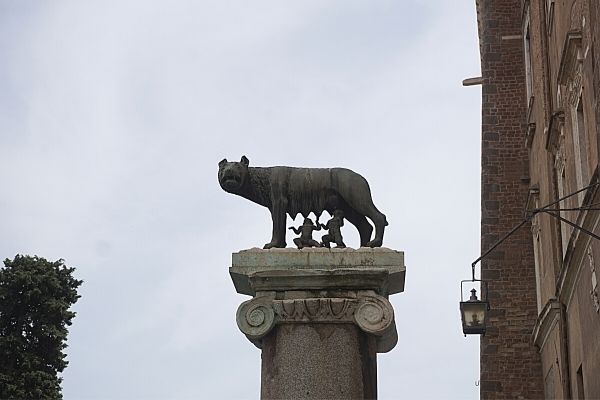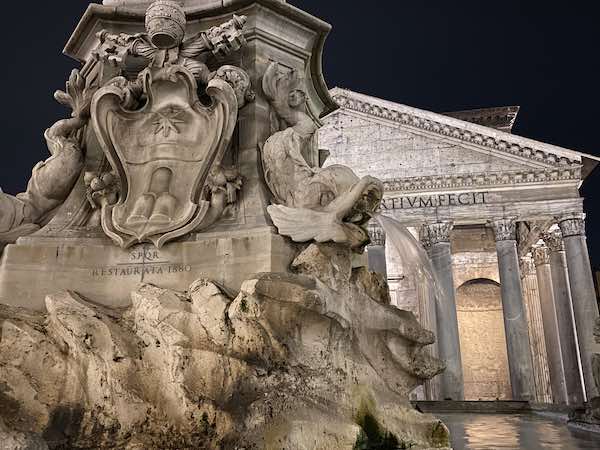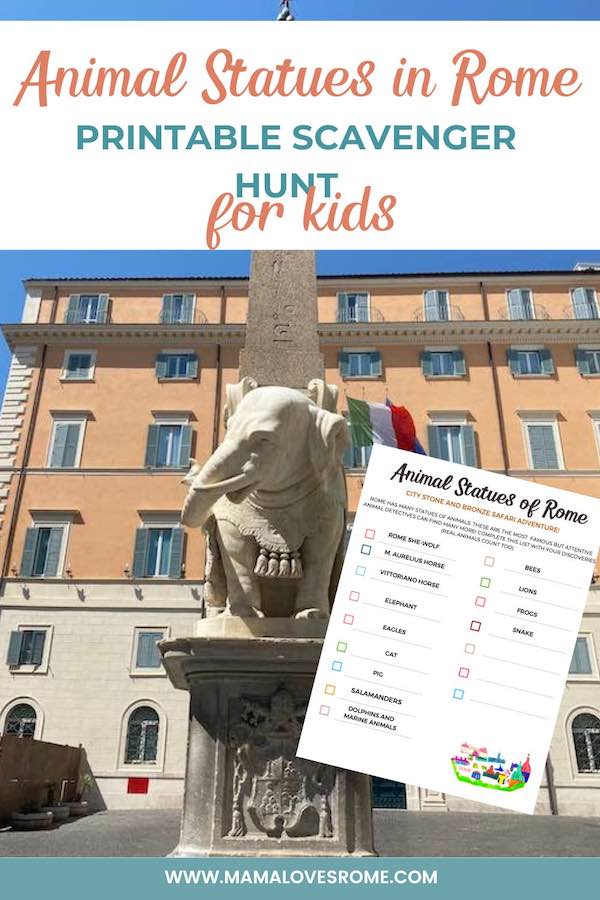Animal statues in Rome: discover funny, unusual, meaningful sculptures of animals in Rome, their location and their stories with this quick guide to Rome’s sculpture zoo.
There are many beautiful statues in Rome.
Among them, there are masterpieces such as Michelangelo’s Pieta’s, Bernini’s Taking of Proserpina, and Canova’s Eros and Psyche, regarded as some of the highest examples of the representation of the human body in art.
However, the city also has a very different type of statues, those representing animals!
Animal statues in Rome are ubiquitous and can be found in piazzas, fountains and museums.
Some of them are famous, some are funny, some are ancient, and some are new, but they all have something in common: animals statues in Rome typically have symbolic meaning and all fun for kids (and adults!) to spot!
In this post, I share a list of the best animal statues in Rome with their location and stories.
I have not organized them in a precise itinerary as I feel they are even more fun to spot if you just set your kids out on a quest: if you are in the center, you’ll find them!
I have, however, marked them on a map, which you can find >>> here <<<
Idea for families visiting Rome with kids: print the list of Rome’s statues of animals you find at the bottom of this article and use it as a simple, fun scavenger hunt for your kids! Little ones can have fun spotting them while older ones may like to refer back to this article to learn stories about them!
Rome’s She-wolf
A list of animal statues in Rome can only start with the Capitoline Wolf, the she-wolf at the center of the myth about the foundation of Rome.

Ancient legends tell us that in the VIII century AD, Vestal Virgin Rhea Silvia conceived two twins, whose father was the God Mars.
This pregnancy caused the anger and worry of King Numitor, who had previously taken the throne form Rhea Silvia’s father and was not worried her children, once grown up, would try and regain the throne.
To prevent this from happening, Numitor ordered the twins to be killed; to save them, Rhea Silvia put them in a basket and let them float aways in the River Tiber.
The basket traveled until the current delivered it on the river shore, where a she-wolf found the starving babies and took it upon herself to nurse them as if they were her own.
The children grew up and one of them, Romulus, became the founder of Rome. Since then, the she-wolf nursing the twins has been regarded as one of the most significant symbols of Rome.
Where you can see her: the original she-wolf is in the Capitoline Museums (ticketed) and a copy is also in Piazza del Campidoglio (free access).
However, many images of her are scattered around Rome, including on taxis as the jersey of the Roma football team!
Bernini’s Elephant
One of the cutest and most unexpected animal statues in Rome is the Bernini’s Elephant, confusingly known as ‘Minerva’s Chick’!
Bernini’s Elephant is a small statue of an elephant you can see in Piazza della Minerva beside the Pantheon.

The Elephant is dressed with a drape, carries a small obelisk on its back, and has a peculiar story.
When Bernini first built the statue, he received criticism from some of his rivals, namely from Father Fontana, a Dominican Friar who had hoped to get his design chosen instead.
Father Fontana claimed that the way he had sculpted it was incompetent and that the back of the Elephant wouldn’t hold the weight of the obelisk.
Pope Alexander VII who paid for the statue got worried and demanded to add support to the Elephant’s belly.
Bernini wasn’t a man to take criticism lightly, so he took a small personal revenge.
While he couldn’t refuse the amendment, he sculpted the posterior of the Elephant with the tail to the side, as if it was showing his bottom to the Dominicans, whose monastery door opens right onto it!
The little Elephant is now one of the most beloved animal sculptures in Rome but this wasn’t always the case. The addition of the support under the belly led many to say that the Elephant didn’t resemble an elephant but rather a pig!
In Italian, they started calling it il Porcino di Minerva (Minerva’s little pig). In Roman dialect, porcino (little pig) and pulcino (chick) sound very similar so often in English you hear this sculpture called Minerva’s chick alto there is no chicken here!
Where you can see it: piazza della Minerva (Pantheon area)
The sow of Via della Scrofa
Rome also has a statue of a pig or, more precisely, a carving of a sow in the street by the same name: via della Scrofa (scrofa= sow, in Italian).
The sow was originally part of a fountain that has since moved: however you can still see the little carving on the wall where it used to be!
Where you can see it: Via della Scrofa
Marcus Aurelius’ Horse
Statues of horses are very common in Rome but one is unique: the equestrian statue of Marcus Aurelius on Capitoline Hill.
There are two such statues: the original is inside the Capitoline Museums and a copy of it is in the center of Piazza del Campidoglio, just outside the museums’ main entrance
The statue is unique as it is the only bronze equestrian statue from Roman times we have!
It is so special, you can see it represented on the 50c Euro coin (get your kids to check!) and the first pages of Italian passports!
Where you can see it: Capitoline Museums / Piazza del Campidoglio

The horse statue on Vittoriano
Another important horse statue in Rome is the one on the Vittoriano.
The statue represents the first King of Italy on a horse and hides a secret: the horse is hollow inside and has a dining room in his belly!
Photos from the time of its construction show an incredible dinner happening there, to celebrate the completion of the Vittoriano works!
Where you can see it: on the Vittoriano, Piazza Venezia
Barberini’s bees
As you walk around Rome you will notice many carvings of bees, on family crests and fountains.
There is a particular reason for this: the bees were the symbol of an important Roman family, the Barberini.
Wealthy and powerful, the Barberini owned several buildings and also commissioned the construction of many fountains and sculptures around the city.
On all of those, bees appear to tell everyone where the money for the construction of the works came from.
Where you can see them: several locations, including Fountain of the Bees (Piazza Barberini), Barcaccia Fountain (Piazza di Spagna), Palazzo Barberini (Via delle Quattro Fontane)

Sant’Eustachio’s stag
Legend tells us that one day, in the II century AD, a Roman soldier was hunting in the woods.
As he came across a beautiful stag, he had a vision: a cross appeared between the deer’s antlers with an image of Jesus, who brought the hunter to convert to Christianity.
We know the soldier as St Eustachio and his church is surmounted by a sculpture of a stag’s head, to recall the story of his conversion.
Where you can see it: on top of the Church of Sant’Eustachio, Piazza Sant’Eustachio (Pantheon area)
The snake of the Fountain of the Four Rivers
The Fountain of the Four Rivers by Bernini is in Piazza Navona and has several exciting animals (a dove, horses, tritons…).
Among the many, there is one that is not easy to see but is worth seeking out: a snake!
You can find it beside the statue representing Rio de la Plata, which is the one with his hand raised in front of his face as if scared. He is scared because the little serpent represents the uncertainty and fear no one can escape from, not even the rich (Rio de la Plata is represented with coins, to showcase wealth).
Eagles
Statues of eagles are everywhere in Rome. Initially the symbol of roman legions and, by extension, the symbol of the city of Rome, you can find them at the top of significant buildings such as Ministries or Military quarters, on columns, gates and more.
The one in the photo is in front of Trajan’s Column in Piazza Venezia.

Turtles
Among the cutest animal statues in Rome there are the turtles of the so called ‘fountain of the turtles‘ in piazza Mattei.
Part of a pretty fountain partially designed by Bernini, the turtles are represented as if they were about to enter the top basin, supported by the hands of young boys.
There is a story connected to this fountain.
Legend tells us that Duke Mattei, who lived on this square, one day lost all of its fortune gambling.
His future father-in-law, horrified by the idea of his daughter marrying a poor man, threatened to cancel the engagement, so Duke Mattei pulled a stunt to impress him.
He pulled all the favors he could get and, overnight, managed to have this beautiful fountain to be built in front of his house.
He then showed it to his father-in-law from his palazzo’s window saying: ‘This is what a penniless Mattei can do in a handful of hours!’.
He then blocked the window for good, so that no one else could enjoy the view!
A fun story but seems to be very much a legend since the fountain pre-dates the palazzo!
Where to see them: Piazza Mattei, 00186 Rome

Frogs
Frogs are the central figures on the Fountains of the Frogs, in the Coppede’ district.
If you see this fountain after the one in Piazza Mattei above, you may notice that stye have elements in common; indeed, the fountain of the frogs has been built as a homage to that of the turtles!
Where to see them: Piazza Mincio, 00198 Rome

Lions
There are several statues of lions in Rome: you can see them carved on buildings (Via Pantaleo), you can find them in museums, often associated with the figure of Hercules, and you can even see them in fountains.
A great example of lion statues in Rome is the appropriately Calle ‘Fountain of the lions’ in the center of Piazza del Popolo.
Here, the lions are represented spitting water, as part of a composition with an Egyptian theme.
Where to see them: Piazza del Popolo

The cat of Via della Gatta
Rome has a special relationship with cats (read here about the cats of Rome) but there is only one statue of a cat in the city, in the appropriately named ‘Via della Gatta’ – the street of the cat.
The statue is small and not super easy to see if you don’t know it is there, making it a fun thing for kids to try spot!
The statue is attached to two legends. The first says the statue is there to remember a cat who, after seeing a child about to fall from a window, miaowed to attract the mother’s attention, saving the child’s life.
The other is that the cat looks towards a treasure buried somewhere in the direction of her gaze. No one, however, has ever managed to find it!
Where to see it: on the first floor of Palazzo Grazioli in Via della Gatta, Rome city center.
Tritons, dolphins and other marine animals
Marine animals and sea creatures are among the most commonly found animal statues in Rome!
You can see them in many fountains including some of the most famous in the city, including the Fountain of the Triton, all the fountains in Piazza Navona, the fountain in front of the Pantheon and several others.
City center addresses where you can see them:
- Piazza della Rotonda (Pantheon)
- Piazza del Tritone (Trevi)
- Piazza Navona (Navona)

Trevi Fountain’s horses
Back to statues of horses, two more deserve mention: those on the Trevi Fountain!
Rather than just being the companions of their human counterparts, the horses of the Trevi Fountain have a symbolic meaning: they represent the ocean on its quiet and rough days. Can you guess which is which?

The salamanders of San Luigi dei Francesi
The main reason to visit the church of San Luigi dei Francesi is its wonderful Caravaggio. However, there are animals to spot on the facade of the church: two fire-spitting salamanders!
Fire salamanders often appear on Christian buildings as a symbol of faith: the fire represents both destruction and regeneration and the salamander is the strength of faith that supports the believer in good and bad times.
Where to see then: Piazza di S. Luigi de’ Francesi, 00186 Roma
Animal statues in Rome’s Museums
Rome museums are home for many wonderful animal statues. Fantastic museums in Rome for animal spotting are:
The Vatican Museums: there is a full hall called ‘Hall of the animals’ animal lovers cannot miss!
Capitoline Museums: animals here are scattered all over the museum and as well as statues, you also have animals paintings here
Borghese Gallery: plenty of animals hidden in the gallery rooms but only some of them are statues, many are painted on the walls and ceilings.
Animal lovers will be however happy to know there are more animal statues in the gardens surrounding the gallery and you even have real ones, in the zoo nearby!
Animal statues in Rome: scavenger hunt for kids – printable
My kids love scavenger hunts and the stone animals of Rome are perfect for a simple scavenger hunt for children!
You can use the pdf at this link >>>> click to open and download (it’s free, it opens in Dropbox so you can print it at home easily) <<<< to challenge them to find as many as possible. The pdf has space to add their own findings: Rome’s stone zoo is even richer than this page suggests!
Animal statues in Rome: List + scavenger hunt for kids – pin this!

